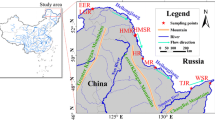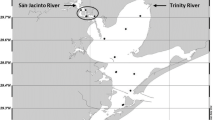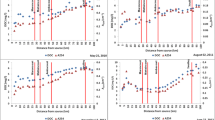Abstract
The development of techniques for real-time monitoring of water quality is of great importance for effectively managing inland water resources. In this study, we first analyzed the absorption and fluorescence properties in a large subtropical reservoir and then used a chromophoric dissolved organic matter (CDOM) fluorescence monitoring sensor to predict several water quality parameters including the total nitrogen (TN), total phosphorus (TP), chemical oxygen demand (COD), dissolved organic carbon (DOC), and CDOM fluorescence parallel factor analysis (PARAFAC) components in the reservoir. The CDOM absorption coefficient at 254 nm (a(254)), the humic-like component (C1), and the tryptophan-like component (C3) decreased significantly along a gradient from the northwest to the lake center, northeast, southwest, and southeast region in the reservoir. However, no significant spatial difference was found for the tyrosine-like component (C2), which contributed only four marked peaks. A highly significant linear correlation was found between the a(254) and CDOM concentration measured using the CDOM fluorescence sensor (r 2 = 0.865, n = 76, p < 0.001), indicating that CDOM concentrations could act as a proxy for the CDOM absorption coefficient measured in the laboratory. Significant correlations were also found between the CDOM concentration and TN, TP, COD, DOC, and the maximum fluorescence intensity of C1, suggesting that the real-time monitoring of CDOM concentrations could be used to predict these water quality parameters and trace the humic-like fluorescence substance in clear aquatic ecosystems with DOC <2 mg/L and total suspended matter (TSM) concentrations <15 mg/L. These results demonstrate that the CDOM fluorescence sensor is a useful tool for on-line water quality monitoring if the empirical relationship between the CDOM concentration measured using the CDOM fluorescence sensor and the water quality parameters is calibrated and validated.








Similar content being viewed by others
References
Andrew D (2005) Standard methods for the examination of water and wastewater, Washington, DC
Association APH (1998): American Water Works Association and Water Environment Federation. Standard methods for the examination of water and wastewater, 20
Baker A (2001) Fluorescence excitation-emission matrix characterization of some sewage-impacted rivers. Environ Sci Technol 35(5):948–953
Baker A (2002) Fluorescence properties of some farm wastes: implications for water quality monitoring. Water Res 36(1):189–195
Baker A, Curry M (2004) Fluorescence of leachates from three contrasting landfills. Water Res 38(10):2605–2613
Baker A, Inverarity R, Charlton M, Richmond S (2003) Detecting river pollution using fluorescence spectrophotometry: case studies from the Ouseburn, NE England. Environ Pollut 124(1):57–70
Battin TJ, Luyssaert S, Kaplan LA, Aufdenkampe AK, Richter A, Tranvik LJ (2009) The boundless carbon cycle. Nat Geosci 2(9):598–600
Bieroza M, Baker A, Bridgeman J (2012) New data mining and calibration approaches to the assessment of water treatment efficiency. Adv Eng Softw 44(1):126–135
Bourgeois W, Burgess JE, Stuetz RM (2001) On-line monitoring of wastewater quality: a review. J Chem Technol Biot 76(4):337–348
Brezonik P, Menken KD, Bauer M (2005) Landsat-based remote sensing of lake water quality characteristics, including chlorophyll and colored dissolved organic matter (CDOM). Lake Reserv Manag 21(4):373–382
Bridgeman J, Bieroza M, Baker A (2011) The application of fluorescence spectroscopy to organic matter characterisation in drinking water treatment. Rev Environ Sci Bio/Techn 10(3):277–290
Brient L, Lengronne M, Bertrand E, Rolland D, Sipel A, Steinmann D, Baudin I, Legeas M, Le Rouzic B, Bormans M (2008) A phycocyanin probe as a tool for monitoring cyanobacteria in freshwater bodies. J Environ Monit 10(2):248–255
Catherine A, Escoffier N, Belhocine A, Nasri A, Hamlaoui S, Yéprémian C, Bernard C, Troussellier M (2012) On the use of the FluoroProbe, a phytoplankton quantification method based on fluorescence excitation spectra for large-scale surveys of lakes and reservoirs. Water Res 46(6):1771–1784
Chen W, Westerhoff P, Leenheer JA, Booksh K (2003) Fluorescence excitation-emission matrix regional integration to quantify spectra for dissolved organic matter. Environ Sci Technol 37(24):5701–5710
Chen Z, Hu C, Muller-Karger FE, Luther ME (2010) Short-term variability of suspended sediment and phytoplankton in Tampa Bay, Florida: observations from a coastal oceanographic tower and ocean color satellites. Estuar Coast Shelf Sci 89(1):62–72
Coble PG (1996) Characterization of marine and terrestrial DOM in seawater using excitation-emission matrix spectroscopy. Mar Chem 51(4):325–346
Conley DJ, Paerl HW, Howarth RW, Boesch DF, Seitzinger SP, Havens KE, Lancelot C, Likens GE (2009) Controlling eutrophication: nitrogen and phosphorus. Science 323(5917):1014–1015
Cory RM, McKnight DM (2005) Fluorescence spectroscopy reveals ubiquitous presence of oxidized and reduced quinones in dissolved organic matter. Environ Sci Technol 39(21):8142–8149
Cory RM, McKnight DM, Chin YP, Miller P, Jaros CL (2007) Chemical characteristics of fulvic acids from Arctic surface waters: microbial contributions and photochemical transformations. J Geophys Res: Biogeosciences (2005–2012) 112 (G4): doi: 10.1029/2006JG000343
Cumberland SA, Baker A (2007) The freshwater dissolved organic matter fluorescence–total organic carbon relationship. Hydrol Process 21(16):2093–2099
Downing BD, Boss E, Bergamaschi BA, Fleck JA, Lionberger MA, Ganju NK, Schoellhamer DH, Fujii R (2009) Quantifying fluxes and characterizing compositional changes of dissolved organic matter in aquatic systems in situ using combined acoustic and optical measurements. Limnol Oceanogr Methods 7(1):119–131
Etheridge JR, Birgand F, Osborne JA, Osburn CL MRB II, Irving J (2014) Using in situ ultraviolet-visual spectroscopy to measure nitrogen, carbon, phosphorus, and suspended solids concentrations at a high frequency in a brackish tidal marsh. Limnol Oceanogr Methods 12(1):10–22
Fellman JB, Hood E, Spencer RG (2010) Fluorescence spectroscopy opens new windows into dissolved organic matter dynamics in freshwater ecosystems: a review. Limnol Oceanogr 55(6):2452–2462
Fichot CG, Benner R (2011) A novel method to estimate DOC concentrations from CDOM absorption coefficients in coastal waters. Geophys Res Lett 38 (L03610): doi:10.1029/2010GL046152
Foden J, Sivyer D, Mills D, Devlin M (2008) Spatial and temporal distribution of chromophoric dissolved organic matter (CDOM) fluorescence and its contribution to light attenuation in UK waterbodies. Estuar Coast Shelf Sci 79(4):707–717
Fontana L, Albuquerque ALS, Brenner M, Bonotto DM, Sabaris TP, Pires MA, Cotrim ME, Bicudo DC (2014) The eutrophication history of a tropical water supply reservoir in Brazil. J Paleolimnol 51(1):29–43
Gregor J, Maršálek B, Šípková H (2007) Detection and estimation of potentially toxic cyanobacteria in raw water at the drinking water treatment plant by in vivo fluorescence method. Water Res 41(1):228–234
Heisler J, Glibert PM, Burkholder JM, Anderson DM, Cochlan W, Dennison WC, Dortch Q, Gobler CJ, Heil CA, Humphries E (2008) Eutrophication and harmful algal blooms: a scientific consensus. Harmful Algae 8(1):3–13
Henderson R, Baker A, Murphy K, Hambly A, Stuetz R, Khan S (2009) Fluorescence as a potential monitoring tool for recycled water systems: a review. Water Res 43(4):863–881
Hur J, Cho J (2012) Prediction of BOD, COD, and total nitrogen concentrations in a typical urban river using a fluorescence excitation-emission matrix with PARAFAC and UV absorption indices. Sensors 12(1):972–986
Kowalczuk P, Cooper WJ, Whitehead RF, Durako MJ, Sheldon W (2003) Characterization of CDOM in an organic-rich river and surrounding coastal ocean in the South Atlantic Bight. Aquat Sci 65(4):384–401
Kowalczuk P, Zablocka M, Sagan S, Kulinski K (2010) Fluorescence measured in situ as a proxy of CDOM absorption and DOC concentration in the Baltic Sea. Oceanologia 52(3):431–471
Kutser T, Pierson DC, Kallio KY, Reinart A, Sobek S (2005) Mapping lake CDOM by satellite remote sensing. Remote Sens Environ 94(4):535–540
Le C, Hu C (2013) A hybrid approach to estimate chromophoric dissolved organic matter in turbid estuaries from satellite measurements: a case study for Tampa Bay. Opt Express 21(16):18849–18871
Lee S, Ahn K (2004) Monitoring of COD as an organic indicator in waste water and treated effluent by fluorescence excitation-emission (FEEM) matrix characterization. Water Sci Technol 50(8):57–63
Lepot M, Aubin J-B, Bertrand-Krajewski J-L (2013) Accuracy of different sensors for the estimation of pollutant concentrations (total suspended solids, total and dissolved chemical oxygen demand) in wastewater and stormwater. Water Sci Technol 68(2):462–471
Li X, Cao F, Chen X, Wang Z, Wang Y (2013) Spatial source apportionment analysis of target pollutant for sensitive area—a case study in Xin’anjiang River Basin for interprovincial assessment section. China Environ Sci 33(9):1714–1720, in Chinese with English abstract
Liu J, Mattiasson B (2002) Microbial BOD sensors for wastewater analysis. Water Res 36(15):3786–3802
Liu X, Zhang Y, Yin Y, Wang M, Qin B (2013) Wind and submerged aquatic vegetation influence bio‐optical properties in large shallow Lake Taihu, China. J Geophys Res: Biogeosciences
Matilainen A, Vepsäläinen M, Sillanpää M (2010) Natural organic matter removal by coagulation during drinking water treatment: a review. Adv Colloid Interfac 159(2):189–197
Matsche N, Stumwöhrer K (1996) UV absorption as control-parameter for biological treatment plants. Water Sci Technol 33(12):211–218
Matsuoka A, Hooker S, Bricaud A, Gentili B, Babin M (2013) Estimating absorption coefficients of colored dissolved organic matter (CDOM) using a semi-analytical algorithm for southern Beaufort Sea waters: application to deriving concentrations of dissolved organic carbon from space. Biogeosciences 10(2):917–927
Mouri G, Takizawa S, Oki T (2011) Spatial and temporal variation in nutrient parameters in stream water in a rural-urban catchment, Shikoku, Japan: effects of land cover and human impact. J Environ Manag 92(7):1837–1848
Mrkva M (1983) Evaluation of correlations between absorbance at 254 nm and COD of river waters. Water Res 17(2):231–235
Murphy J, Riley J (1962) A modified single solution method for the determination of phosphate in natural waters. Anal Chim Acta 27:31–36
Murphy KR, Ruiz GM, Dunsmuir WT, Waite TD (2006) Optimized parameters for fluorescence-based verification of ballast water exchange by ships. Environ Sci Technol 40(7):2357–2362
Otis DB, Carder KL, English DC, Ivey JE (2004) CDOM transport from the Bahamas Banks. Coral Reefs 23(1):152–160
Otten T, Xu H, Qin B, Zhu G, Paerl H (2012) Spatiotemporal patterns and ecophysiology of toxigenic Microcystis blooms in Lake Taihu, China: implications for water quality management. Environ Sci Technol 46(6):3480–3488
Paerl H, Fulton III R (2006): Ecology of harmful cyanobacteria. Ecology of harmful algae. Springer, PP 95–109
Para J, Coble PG, Charrière B, Tedetti M, Fontana C, Sempéré R (2010) Fluorescence and absorption properties of chromophoric dissolved organic matter (CDOM) in coastal surface waters of the Northwestern Mediterranean Sea (Bay of Marseilles, France). Biogeosci Discuss 7(4):5675–5718
Porter J, Arzberger P, Braun H-W, Bryant P, Gage S, Hansen T, Hanson P, Lin C-C, Lin F-P, Kratz T (2005) Wireless sensor networks for ecology. Bioscience 55(7):561–572
Qin B, Xu P, Wu Q, Luo L, Zhang Y (2007) Environmental issues of Lake Taihu, China. Hydrobiologia 581(1): 3–14.
Qin B, Zhu G, Gao G, Zhang Y, Li W, Paerl HW, Carmichael WW (2010) A drinking water crisis in Lake Taihu, China: linkage to climatic variability and lake management. Environ Manag 45(1):105–112
Saraceno JF, Pellerin BA, Downing BD, Boss E, Bachand PAM, Bergamaschi BA (2009) High-frequency in situ optical measurements during a storm event: assessing relationships between dissolved organic matter, sediment concentrations, and hydrologic processes. J Geophys Res 114 (G4): doi: 10.1029/2009jg000989
Shutova Y, Baker A, Bridgeman J, Henderson RK (2014) Spectroscopic characterisation of dissolved organic matter changes in drinking water treatment: from PARAFAC analysis to online monitoring wavelengths. Water Res 54(1):159–169
State Environment Protection Administration of China (2002) Analysis of water quality monitoring standards of practice handbook. In: fourth (Editor). China Environment Science Press, Beijing, pp 210–234, in Chinese with English abstract
Stedmon CA, Bro R (2008) Characterizing dissolved organic matter fluorescence with parallel factor analysis: a tutorial. Limnol Oceanogr Methods 6(1):572–579
Tan X, Min H (2004) Ecological environment problems and protection measures of Lake Qiandaohu. Environ Pollut Control 26(3):200–203, in Chinese with English abstract
Thomas O, El Khorassani H, Touraud E, Bitar H (1999) TOC versus UV spectrophotometry for wastewater quality monitoring. Talanta 50(4):743–749
Thurman EM (1985) Organic geochemistry of natural waters. Kluwer Acad, Boston, Mass
Vasel JL, Praet E (2002) On the use of fluorescence measurements to characterize wastewater. Water Sci Technol 45(4–5):109–116
Wang XL, Wang Q, Wu CQ, Liang T, Zheng DH, Wei XF (2012) A method coupled with remote sensing data to evaluate non-point source pollution in the Xin’anjiang catchment of China. Sci Total Environ 430:132–143
Wu J, Pons M, Potier O (2006) Wastewater fingerprinting by UV-visible and synchronous fluorescence spectroscopy. Water Sci Technol 53(4–5):449–456
Yamashita Y, Jaffé R, Male N, Tanoue E (2008) Assessing the dynamics of dissolved organic matter (DOM) in coastal environments by excitation emission matrix fluorescence and parallel factor analysis (EEM-PARAFAC). Limnol Oceanogr 53(5):1900–1908
Yan L, Chen X, Su R, Han X, Zhang C, Shi X (2013) Resolving characteristic of CDOM by excitation-emission matrix spectroscopy combined with parallel factor analysis in the seawater of outer Yangtze Estuary in autumn in 2010. Environ Sci 34(1):51–60 (in Chinese with English abstract)
Yin Y, Zhang Y, Liu X, Zhu G, Qin B, Shi Z, Feng L (2011) Temporal and spatial variations of chemical oxygen demand in Lake Taihu, China, from 2005 to 2009. Hydrobiologia 665(1):129–141
Zhang Y, Qin B, Zhu G, Zhang L, Yang L (2007) Chromophoric dissolved organic matter (CDOM) absorption characteristics in relation to fluorescence in Lake Taihu, China, a large shallow subtropical lake. Hydrobiologia 581(1):43–52
Zhang Y, van Dijk MA, Liu M, Zhu G, Qin B (2009) The contribution of phytoplankton degradation to chromophoric dissolved organic matter (CDOM) in eutrophic shallow lakes: field and experimental evidence. Water Res 43(18):4685–4697
Zhang Y, Yin Y, Feng L, Zhu G, Shi Z, Liu X, Zhang Y (2011) Characterizing chromophoric dissolved organic matter in Lake Tianmuhu and its catchment basin using excitation-emission matrix fluorescence and parallel factor analysis. Water Res 45(16):5110–5122
Zhang Y, Liu X, Wang M, Qin B (2013) Compositional differences of chromophoric dissolved organic matter derived from phytoplankton and macrophytes. Org Geochem 55(1):26–37
Acknowledgments
We would like to thank the help of Wu Zhixu in the field work. The study was jointly funded by the Provincial Nature Science Foundation of Jiangsu of China (BK2012050), the National Natural Science Foundation of China (41325001, 41271355), the Key Program of the Nanjing Institute of Geography and Limnology, Chinese Academy of Sciences (NIGLAS2012135003), and the Environmental Protection Agency of Chun’an County, Zhejiang, in China.
Author information
Authors and Affiliations
Corresponding author
Additional information
Responsible editor: Philippe Garrigues
This manuscript has not been published or has not been accepted elsewhere. It is will not be submitted to any other journal in the following three months. The manuscript is organized according to the format and structure of your journal.
Rights and permissions
About this article
Cite this article
Liu, X., Zhang, Y., Shi, K. et al. Absorption and fluorescence properties of chromophoric dissolved organic matter: implications for the monitoring of water quality in a large subtropical reservoir. Environ Sci Pollut Res 21, 14078–14090 (2014). https://doi.org/10.1007/s11356-014-3319-4
Received:
Accepted:
Published:
Issue Date:
DOI: https://doi.org/10.1007/s11356-014-3319-4




